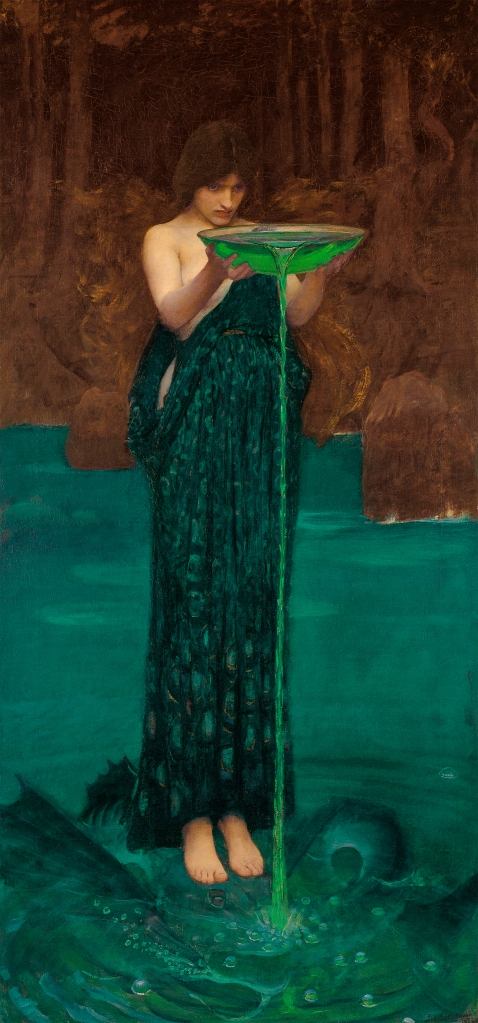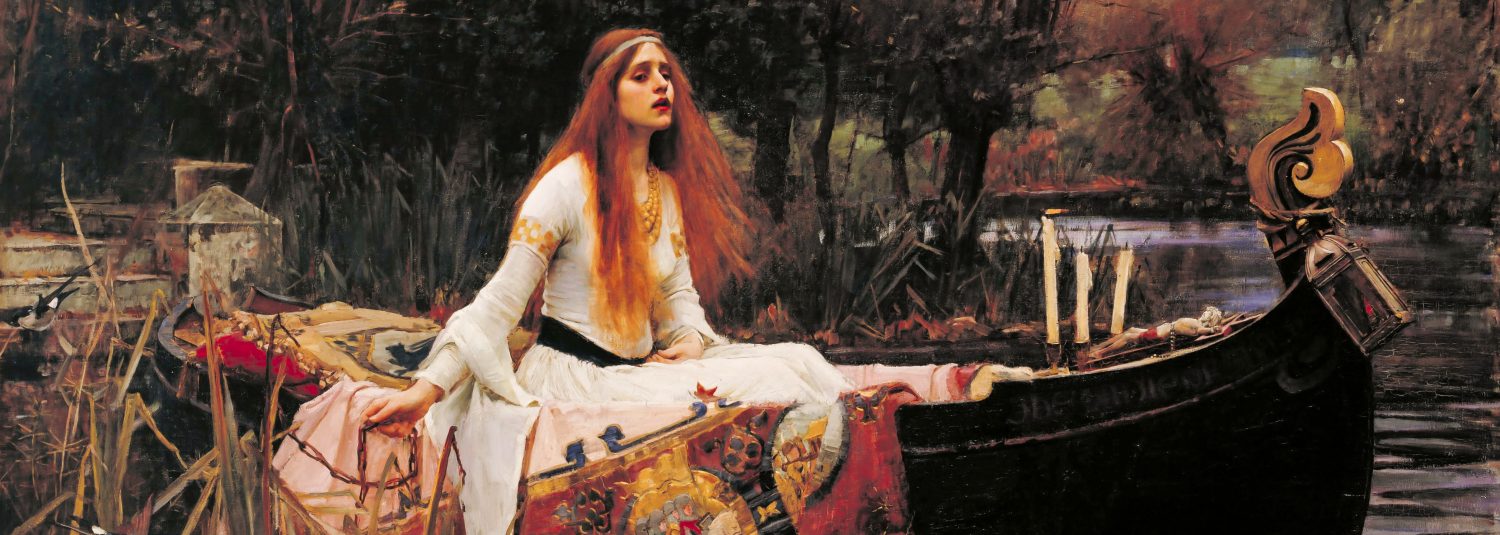
In Ovid’s Metamorphosis the merman Glaucus desires the nymph Scylla and begs Circe to charm her into returning his affections. But as Circe is invidiosa (Latin for jealous) and wants Glaucus for herself, she poisons the waters in which Scylla bathes, causing her to be transformed into a sailor-devouring monster. In John William Waterhouse’s Circe invidiosa 1892, the sorceress is shown bolt upright, focused intently on holding the large vessel and controlling the stream of liquid, her weight and the poison serving to contain the nymph-monster below. Angus Trumble observes that the figure:
“derives great expressive power from the almost liturgical formality with which the sorceress administers her poison. The peacock robe, the bowed head, erect posture and air of concentration, the ceremonial way she holds up the bowl with both hands and slowly drains the green concoction … suggest the solemnity of a perverted ritual.” (1)
Circe’s emphatic verticality is countered by the diagonals and curves of the broadly rendered landscape. The tree trunks are crowned with a fringe of foliage, while the rock forms and swirling waters are so stylised as to lack any substance. Indeed, the calligraphic quality, dimensions and proportions of Waterhouse’s canvas are inspired by Asian screens and show the impact of Japanese art more generally. The painting also demonstrates the artist’s awareness of new developments in archaeology, anthropology, comparative mythology, the study of ancient and modern religions, occultism and the revival of paganism. (2)
Waterhouse had painted another Circe the previous year, Circe offering the cup to Ulysses (3), showing the sorceress seated on a throne holding a cup and wand aloft, with Ulysses and his ship reflected in the mirror behind her and a seaman-turned-boar at her feet. Circe invidiosa is, by contrast, remarkably economical, both in palette and attributes. Glaucus, previously a mortal man, discovered a herb that brought back to life the fish he had caught, and decided to try it himself. The substance gave him fins and a tail, as well as immortality, and Waterhouse plays with these notions of transformation. Trumble points out that the artist retouched the painting before sending it to the Art Gallery of South Australia, changing several aspects of the composition, including softening the pattern of ripples on the water’s surface, and making the serpentine tail less visible and therefore more sinister. (4)
A critic at the time described Circe invidiosa as a ‘Burne-Jones and French mixture, strange, interesting and beautiful in colour’. (5) Another went further, declaring Circe invidiosa an ‘excellent example of professional French painting’, and pointing out how the drawing is planned ‘geometrically [and] the modelling is built up mechanically’ but, ultimately, concluding the work ‘theatrical and pedantic’. (6) The comparison to contemporary French art was largely due to Waterhouse’s complex layering, thick brushwork, use of impasto and the ways he builds up the flesh, hair and drapery. Elizabeth Prettejohn proposes a more personal reason for the palette, suggesting that Waterhouse took inspiration from his time in Italy: the caves of Capri and the Amalfi Coast famous for their blue-green water and light effects. (7)
– Lucina Ward
1. Angus Trumble, Love and death: Art in the age of Queen Victoria, Art Gallery of South Australia, Adelaide, 2001, p 102.
2. Elizabeth Prettejohn, ‘Waterhouse’s imagination’, in Elizabeth Prettejohn, Peter Trippi, Robert Upston and Patty Wageman, JW Waterhouse: The modern Pre-Raphaelite, Royal Academy of Arts, London, 2008, pp 23–9, at p 23.
3. Collection Oldham Art Gallery, Manchester.
4. Trumble, p 102.
5. Saturday Review, 14 May 1892, p 569; quoted by Peter Trippi, JW Waterhouse, Phaidon Press, London and New York, 2002 p 116.
6. Fortnightly Review, no 57, 1892, p 833; quoted by Trippi, p 115.
7. Prettejohn et al, p 120.

One thought on “Circe Invidiosa”
Comments are closed.